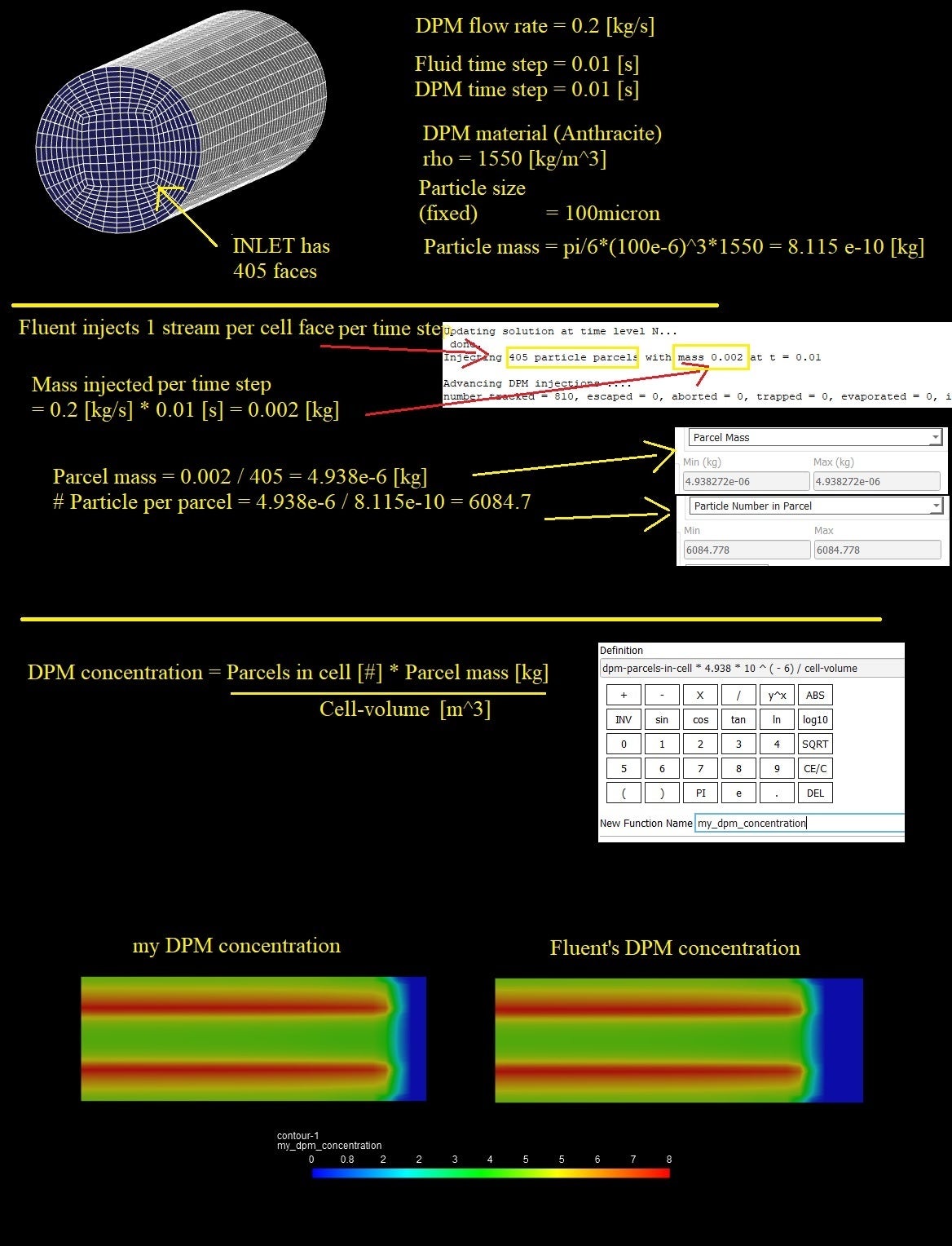TAGGED: dpm, dpm-concentration, fluent
-
-
December 2, 2021 at 10:56 pm
SpencerJordan
SubscriberHello! I am wondering if someone can help me clear up what is meant by the 'DPM Concentration' variable in Fluent. I have a simulation with several surfaces where I am exporting DPM Concentration across these surfaces at every time-step. What I'm confused about is how this concentration is being calculated on a 2D surface (since concentration is usually in 3D), and what exactly the units are. Any help would be appreciated, thanks in advance.
December 3, 2021 at 1:18 pmai0013
SubscriberI guess your simulation is 3D and you exporting DPM concentration at various 2D slices? Fluent will simply interpolate to color the contour at your surfaces.
In general, DPM concentration is a "type" of density that relates the mass of particles in cell [kg] divided by the cell volume [m^3]. Units are then [kg/m^3]. This is stored as a Eulerian Field.
Remember that we coloquially call "particles" what actually "parcels" are to the CFD code.
DPM concentration [kg/m^3] = parcels in cell [#] * Parcel mass [kg] / Cell volume [m^3]
Parcel mass [kg] = DPM flow rate [kg/s] * DPM time step / # Streams
Where # Streams depend on the type of injection , PSD distribution, parcel release method ...
For example, for surface injection and standard parcel release method only

The high DPM concentration region (red parallel lines) is due to the smaller cell size at that zone. Activating the 'scale Flow rate by Area' option can remedy this. My example is valid for constant mass in a parcel, which is not necessarily true for other cases. I hope this example illustrates the concept.
Keep in mind that other settings involving PSD, other type of injection, parcel release method, 'scale flow by area' will need other treatment. Perhaps Ansys Staff can jump in to provide more general expression
December 3, 2021 at 3:07 pmSpencerJordan
SubscriberThanks so much for the detailed response that clears things up!
December 3, 2021 at 3:25 pmRahul Kumar
Ansys EmployeeThank you for your answer .
December 3, 2021 at 10:31 pmSpencerJordan
SubscriberI have a follow-up question to this post that I'm hoping you can help with. In my simulation, I want to count the DPM mass present on several surfaces every time-step and export this as a file. Currently, I have report definitions set up to record the 'sum' of a variable I defined as: (DPM-concentration*cell-volume), hoping that this would result in DPM-mass. The problem I'm seeing is that my results do not always make sense, specifically the mass seems to be way off between surfaces of different sizes in my simulation. Is the expression above that I defined for DPM-mass somehow dependent on the area of the surface I'm reporting it over? Again, any help would be greatly appreciated.
December 3, 2021 at 10:35 pmSpencerJordan
SubscriberTo give some more details: I am using a surface injection that injects for a single timestep, and I am tracking this single pulse as it moves down a column that narrows towards the outlet. The surfaces I'm reporting the DPM-mass over are iso-surfaces defined along the length of the column (but since it gets narrower, they do not have equal surface area). The file is successfully exporting the DPM-mass I defined, and it makes sense temporally, but the total sum of the masses between surfaces seem too far off from one another to be true.
December 8, 2021 at 11:32 amRob
Forum ModeratorIf you sum DPM Concentration*cell volume over the whole domain how does that tie up over the run?
Viewing 6 reply threads- The topic ‘DPM Concentration on Surfaces’ is closed to new replies.
Innovation SpaceTrending discussions- air flow in and out of computer case
- Varying Bond model parameters to mimic soil particle cohesion/stiction
- Eroded Mass due to Erosion of Soil Particles by Fluids
- I am doing a corona simulation. But particles are not spreading.
- Centrifugal Fan Analysis for Determination of Characteristic Curve
- Guidance needed for Conjugate Heat Transfer Analysis for a 3s3p Li-ion Battery
- Issue to compile a UDF in ANSYS Fluent
- JACOBI Convergence Issue in ANSYS AQWA
- affinity not set
- Resuming SAG Mill Simulation with New Particle Batch in Rocky
Top Contributors-
4107
-
1487
-
1318
-
1156
-
1021
Top Rated Tags© 2025 Copyright ANSYS, Inc. All rights reserved.
Ansys does not support the usage of unauthorized Ansys software. Please visit www.ansys.com to obtain an official distribution.
-











